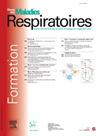Counteracting pulmonary vascular endothelial cell senescence to combat age-related lung dysfunction and pulmonary hypertension
IF 0.5
4区 医学
Q4 RESPIRATORY SYSTEM
引用次数: 0
Abstract
Senescent endothelial cells (ECs) represent 30 to 50 % of senescent lung cells during aging and/or development of several lung diseases, including pulmonary hypertension (PH) (Born E et al, Circulation 2023) and emphysema. One potential mechanism is impaired angiogenic vascular endothelial growth factor (VEGF) signalling due to increased production of the soluble form of VEGF receptor 1 (sVEGFR1) via alternative splicing of VEGFR1. sVEGFR1 then acts as a VEGF trap.
The objective is to evaluate the role of impaired VEGF signalling in pulmonary EC senescence during aging and the development of PH and emphysema.
To characterize the lung expression of sVEGFR1 and VEGF receptors in the lung endothelial cells of young and old patients (classified as emphysematous and controls) undergoing lung surgery, 90 patients will be included during the candidate PhD.
In parallel, the lung expression of sVEGFR1 and VEGF receptors will be assessed in young and old mice [developing moderate emphysema and PAH], as well as in mouse models of PH (exposure to chronic hypoxia combined to SUGEN) and emphysema (elastase, elastin± mice), and mice with elimination of senescent cells (ABT senolytic treatment), linked to the rarefaction of the pulmonary capillary network (ICAM-1/CD31labelling) and the accumulation of senescent ECs (measurement of senescence and DNA damage markers p16, p21).
To counter EC senescence during aging and PH development, we generated a new mouse model overexpressing VEGF via a constitutive or tissue-specific inducible system allowing controlled delivery of VEGF from the liver to the lungs (VEGF-TG mice).
The lungs of aged mice compared to young mice have lower capillary density, manifested by a reduction in the number of ECs stained for ICAM1. Treatment of mice with the VEGF receptor inhibitor Sugen amplifies these effects and increases the number of p16-marked senescent ECs, thereby reducing the pulmonary capillary network, impairing pulmonary hemodynamics, and inducing emphysema. Lung expression of sVEGFR1 in mice developing hypoxic PH is increased and worsened by Sugen.
We show in vitro that sVEGFR1 treatment of cultured ECs from patients leads to cellular senescence. Conversely, VEGF treatment reduces endothelial cell senescence and improves proliferation. Senescent endothelial cells produce less sVEGFR1 in both controls and lung emphysema patients. Emphysema patients show higher EC senescence with higher p16 RNA level and B-galactosidase stained cells. ECs from emphysema patients show a lower cumulative PDL level than control patients. Furthermore, in both control and emphysema patients, there is a tendency towards decreased VEGFR1/2 and sVEGFR1 RNA expression in senescent ECs.
The results obtained in old VEGF-TG mice show the preservation of pulmonary microvascular density as well as the suppression of p16-stained cells and protection against pulmonary emphysema. Next, young mice overexpressing VEGF in the liver were exposed to hypoxia to observe whether they are protected from hypoxic pulmonary hypertension compared to control and littermate mice, results are in progress.
Enhanced VEGF signalling protects against pulmonary EC senescence and emphysema during aging, with expected protective effects on the development of PH.
求助全文
约1分钟内获得全文
求助全文
来源期刊

Revue des maladies respiratoires
医学-呼吸系统
CiteScore
1.10
自引率
16.70%
发文量
168
审稿时长
4-8 weeks
期刊介绍:
La Revue des Maladies Respiratoires est l''organe officiel d''expression scientifique de la Société de Pneumologie de Langue Française (SPLF). Il s''agit d''un média professionnel francophone, à vocation internationale et accessible ici.
La Revue des Maladies Respiratoires est un outil de formation professionnelle post-universitaire pour l''ensemble de la communauté pneumologique francophone. Elle publie sur son site différentes variétés d''articles scientifiques concernant la Pneumologie :
- Editoriaux,
- Articles originaux,
- Revues générales,
- Articles de synthèses,
- Recommandations d''experts et textes de consensus,
- Séries thématiques,
- Cas cliniques,
- Articles « images et diagnostics »,
- Fiches techniques,
- Lettres à la rédaction.
 求助内容:
求助内容: 应助结果提醒方式:
应助结果提醒方式:


